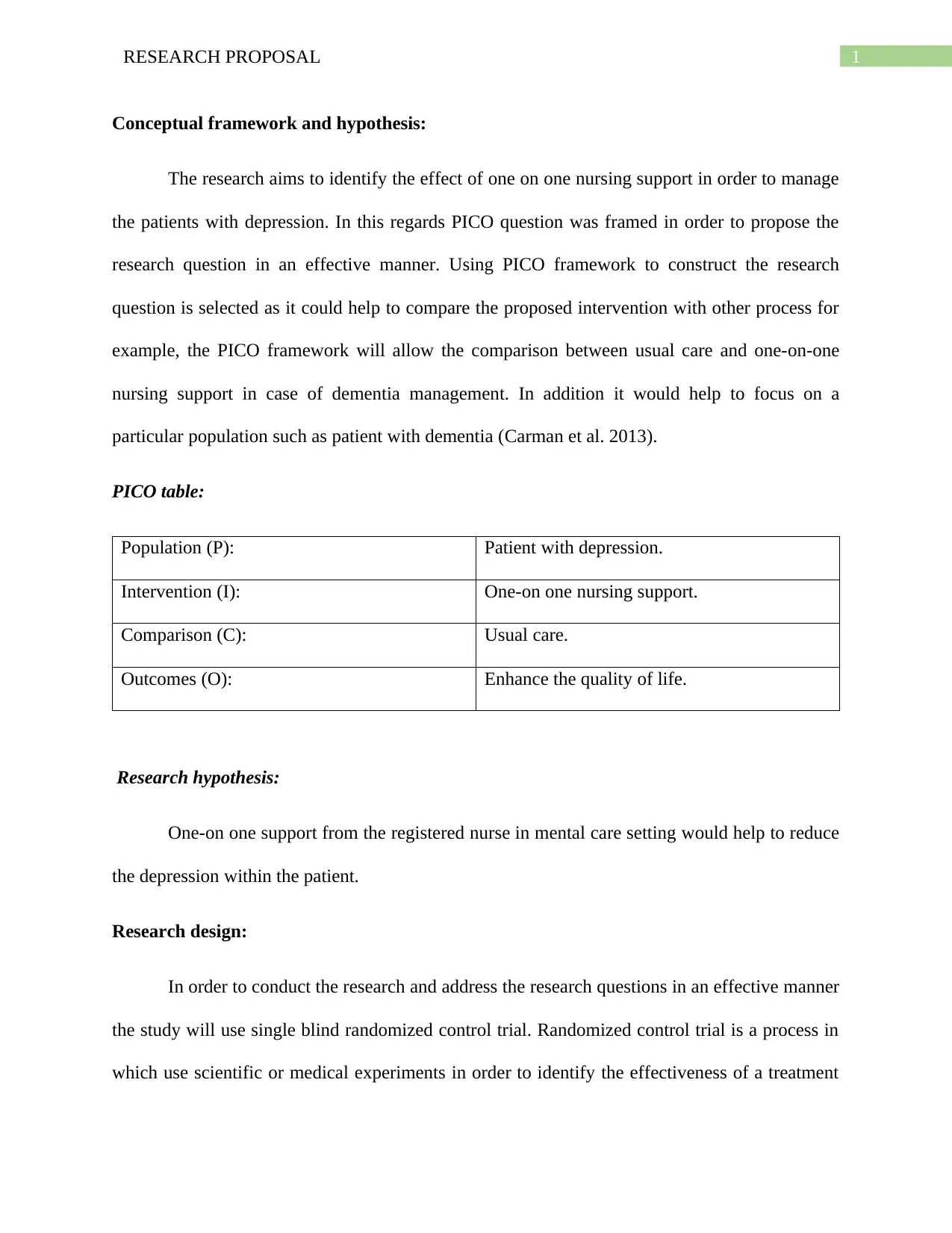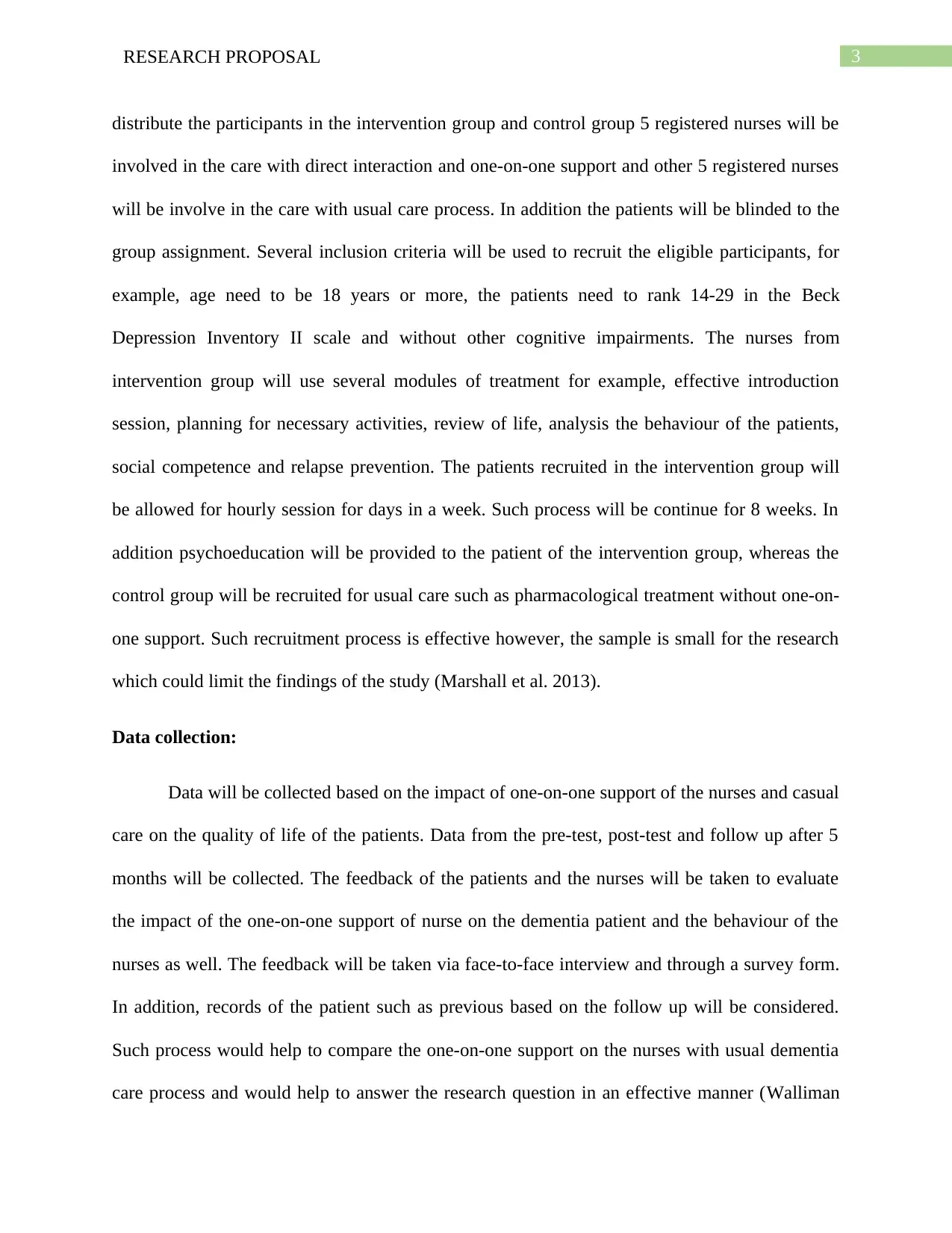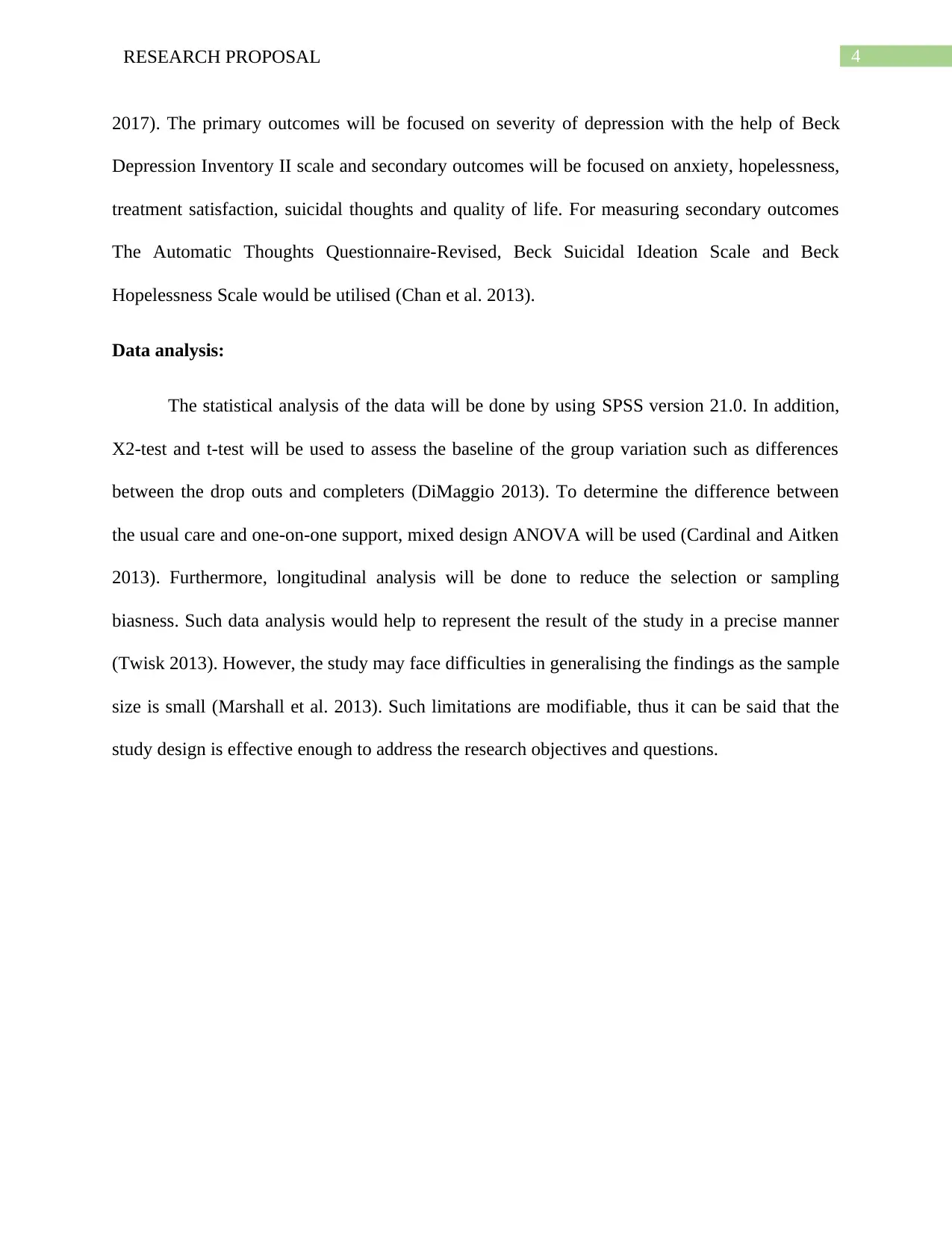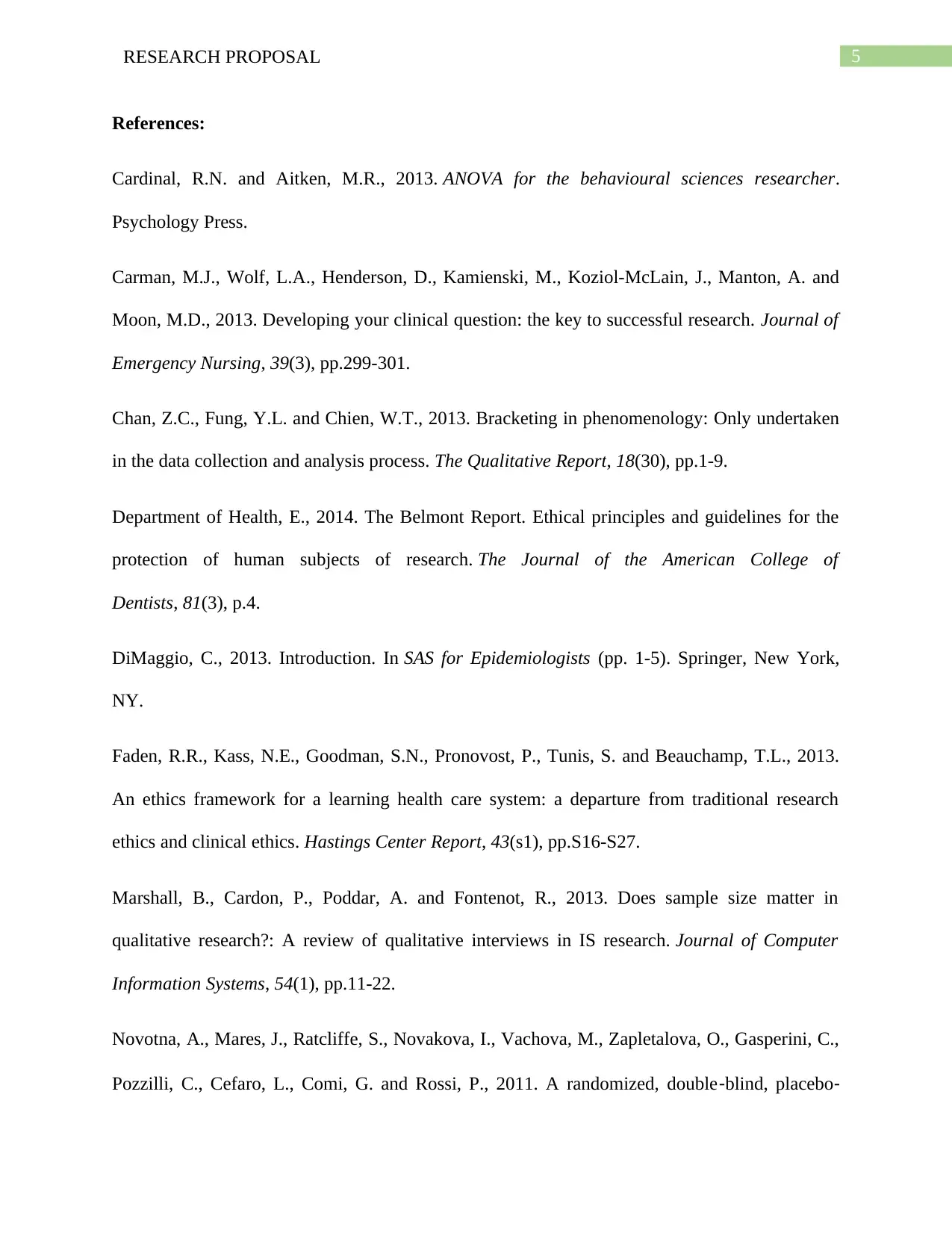CNA688 Research Proposal: One-on-One Nursing Support for Depression
VerifiedAdded on 2023/06/04
|7
|1620
|212
Report
AI Summary
This research proposal outlines a study to investigate the effect of one-on-one nursing support on patients with depression. Utilizing a single-blind randomized control trial design, the study aims to compare the outcomes of patients receiving one-on-one nursing support versus those receiving usual care. The proposal details the PICO framework used to formulate the research question, the recruitment process involving 40 participants (10 registered nurses and 30 patients with severe depression) from a mental care facility, and the data collection methods including pre-tests, post-tests, follow-up interviews, and surveys. Data analysis will employ SPSS version 21.0, X2-test, t-tests, and mixed design ANOVA to assess the impact of the intervention on the severity of depression, anxiety, hopelessness, treatment satisfaction, suicidal thoughts, and overall quality of life. Ethical considerations and potential limitations, such as the small sample size, are also addressed.

Running head: RESEARCH PROPOSAL
RESEARCH PROPOSAL
Name of the student:
Name of the University:
Author note:
RESEARCH PROPOSAL
Name of the student:
Name of the University:
Author note:
Paraphrase This Document
Need a fresh take? Get an instant paraphrase of this document with our AI Paraphraser

1RESEARCH PROPOSAL
Conceptual framework and hypothesis:
The research aims to identify the effect of one on one nursing support in order to manage
the patients with depression. In this regards PICO question was framed in order to propose the
research question in an effective manner. Using PICO framework to construct the research
question is selected as it could help to compare the proposed intervention with other process for
example, the PICO framework will allow the comparison between usual care and one-on-one
nursing support in case of dementia management. In addition it would help to focus on a
particular population such as patient with dementia (Carman et al. 2013).
PICO table:
Population (P): Patient with depression.
Intervention (I): One-on one nursing support.
Comparison (C): Usual care.
Outcomes (O): Enhance the quality of life.
Research hypothesis:
One-on one support from the registered nurse in mental care setting would help to reduce
the depression within the patient.
Research design:
In order to conduct the research and address the research questions in an effective manner
the study will use single blind randomized control trial. Randomized control trial is a process in
which use scientific or medical experiments in order to identify the effectiveness of a treatment
Conceptual framework and hypothesis:
The research aims to identify the effect of one on one nursing support in order to manage
the patients with depression. In this regards PICO question was framed in order to propose the
research question in an effective manner. Using PICO framework to construct the research
question is selected as it could help to compare the proposed intervention with other process for
example, the PICO framework will allow the comparison between usual care and one-on-one
nursing support in case of dementia management. In addition it would help to focus on a
particular population such as patient with dementia (Carman et al. 2013).
PICO table:
Population (P): Patient with depression.
Intervention (I): One-on one nursing support.
Comparison (C): Usual care.
Outcomes (O): Enhance the quality of life.
Research hypothesis:
One-on one support from the registered nurse in mental care setting would help to reduce
the depression within the patient.
Research design:
In order to conduct the research and address the research questions in an effective manner
the study will use single blind randomized control trial. Randomized control trial is a process in
which use scientific or medical experiments in order to identify the effectiveness of a treatment

2RESEARCH PROPOSAL
or care process while reducing biasness (Novotna et al. 2011). Thus, it can be said that the
selected study design is appropriate for the research as it aims to determine the effectiveness of
one-on-one nursing support for the patient with dementia.
Design strategy:
In order to utilise the method of single blind randomized control trail the study will
introduce two groups such as intervention group and control group. Equal numbers of
participants will be randomised in the two groups. Before conducting the research the registered
nurse and the patients will be informed regarding the importance of the research. Participants
will not be forced to participate in the study, they will be recruited in the study with their consent
and a consent form will be signed by each participants before recruitment (Walliman 2017).
Ethical consideration will be taken from the Human Resource department of the mental health
facility. Such study strategy will help to maintain the ethics of the research in an effective
manner and will help to avoid any ethical or legal issue during the research (Faden et al. 2013).
Study has informed that research that includes human subjects or participants may raise different
ethical, legal, political and social issues which may affect the research in an effective manner
(Department of Health 2014). In some cases due to such issue the research process may be
restricted and the researchers may need to stop their study. Thus, it is important to consider the
ethical aspects while preparing strategy for the research design (Faden et al. 2013).
Sample and recruitment process:
By maintaining the above study design and ethics the study will recruit 40 participants
including 10 registered nurses and 30 patients who are suffering from severe depression. The
participants will be recruited from a mental care facility for a period of 2 months. In order to
or care process while reducing biasness (Novotna et al. 2011). Thus, it can be said that the
selected study design is appropriate for the research as it aims to determine the effectiveness of
one-on-one nursing support for the patient with dementia.
Design strategy:
In order to utilise the method of single blind randomized control trail the study will
introduce two groups such as intervention group and control group. Equal numbers of
participants will be randomised in the two groups. Before conducting the research the registered
nurse and the patients will be informed regarding the importance of the research. Participants
will not be forced to participate in the study, they will be recruited in the study with their consent
and a consent form will be signed by each participants before recruitment (Walliman 2017).
Ethical consideration will be taken from the Human Resource department of the mental health
facility. Such study strategy will help to maintain the ethics of the research in an effective
manner and will help to avoid any ethical or legal issue during the research (Faden et al. 2013).
Study has informed that research that includes human subjects or participants may raise different
ethical, legal, political and social issues which may affect the research in an effective manner
(Department of Health 2014). In some cases due to such issue the research process may be
restricted and the researchers may need to stop their study. Thus, it is important to consider the
ethical aspects while preparing strategy for the research design (Faden et al. 2013).
Sample and recruitment process:
By maintaining the above study design and ethics the study will recruit 40 participants
including 10 registered nurses and 30 patients who are suffering from severe depression. The
participants will be recruited from a mental care facility for a period of 2 months. In order to
⊘ This is a preview!⊘
Do you want full access?
Subscribe today to unlock all pages.

Trusted by 1+ million students worldwide

3RESEARCH PROPOSAL
distribute the participants in the intervention group and control group 5 registered nurses will be
involved in the care with direct interaction and one-on-one support and other 5 registered nurses
will be involve in the care with usual care process. In addition the patients will be blinded to the
group assignment. Several inclusion criteria will be used to recruit the eligible participants, for
example, age need to be 18 years or more, the patients need to rank 14-29 in the Beck
Depression Inventory II scale and without other cognitive impairments. The nurses from
intervention group will use several modules of treatment for example, effective introduction
session, planning for necessary activities, review of life, analysis the behaviour of the patients,
social competence and relapse prevention. The patients recruited in the intervention group will
be allowed for hourly session for days in a week. Such process will be continue for 8 weeks. In
addition psychoeducation will be provided to the patient of the intervention group, whereas the
control group will be recruited for usual care such as pharmacological treatment without one-on-
one support. Such recruitment process is effective however, the sample is small for the research
which could limit the findings of the study (Marshall et al. 2013).
Data collection:
Data will be collected based on the impact of one-on-one support of the nurses and casual
care on the quality of life of the patients. Data from the pre-test, post-test and follow up after 5
months will be collected. The feedback of the patients and the nurses will be taken to evaluate
the impact of the one-on-one support of nurse on the dementia patient and the behaviour of the
nurses as well. The feedback will be taken via face-to-face interview and through a survey form.
In addition, records of the patient such as previous based on the follow up will be considered.
Such process would help to compare the one-on-one support on the nurses with usual dementia
care process and would help to answer the research question in an effective manner (Walliman
distribute the participants in the intervention group and control group 5 registered nurses will be
involved in the care with direct interaction and one-on-one support and other 5 registered nurses
will be involve in the care with usual care process. In addition the patients will be blinded to the
group assignment. Several inclusion criteria will be used to recruit the eligible participants, for
example, age need to be 18 years or more, the patients need to rank 14-29 in the Beck
Depression Inventory II scale and without other cognitive impairments. The nurses from
intervention group will use several modules of treatment for example, effective introduction
session, planning for necessary activities, review of life, analysis the behaviour of the patients,
social competence and relapse prevention. The patients recruited in the intervention group will
be allowed for hourly session for days in a week. Such process will be continue for 8 weeks. In
addition psychoeducation will be provided to the patient of the intervention group, whereas the
control group will be recruited for usual care such as pharmacological treatment without one-on-
one support. Such recruitment process is effective however, the sample is small for the research
which could limit the findings of the study (Marshall et al. 2013).
Data collection:
Data will be collected based on the impact of one-on-one support of the nurses and casual
care on the quality of life of the patients. Data from the pre-test, post-test and follow up after 5
months will be collected. The feedback of the patients and the nurses will be taken to evaluate
the impact of the one-on-one support of nurse on the dementia patient and the behaviour of the
nurses as well. The feedback will be taken via face-to-face interview and through a survey form.
In addition, records of the patient such as previous based on the follow up will be considered.
Such process would help to compare the one-on-one support on the nurses with usual dementia
care process and would help to answer the research question in an effective manner (Walliman
Paraphrase This Document
Need a fresh take? Get an instant paraphrase of this document with our AI Paraphraser

4RESEARCH PROPOSAL
2017). The primary outcomes will be focused on severity of depression with the help of Beck
Depression Inventory II scale and secondary outcomes will be focused on anxiety, hopelessness,
treatment satisfaction, suicidal thoughts and quality of life. For measuring secondary outcomes
The Automatic Thoughts Questionnaire-Revised, Beck Suicidal Ideation Scale and Beck
Hopelessness Scale would be utilised (Chan et al. 2013).
Data analysis:
The statistical analysis of the data will be done by using SPSS version 21.0. In addition,
X2-test and t-test will be used to assess the baseline of the group variation such as differences
between the drop outs and completers (DiMaggio 2013). To determine the difference between
the usual care and one-on-one support, mixed design ANOVA will be used (Cardinal and Aitken
2013). Furthermore, longitudinal analysis will be done to reduce the selection or sampling
biasness. Such data analysis would help to represent the result of the study in a precise manner
(Twisk 2013). However, the study may face difficulties in generalising the findings as the sample
size is small (Marshall et al. 2013). Such limitations are modifiable, thus it can be said that the
study design is effective enough to address the research objectives and questions.
2017). The primary outcomes will be focused on severity of depression with the help of Beck
Depression Inventory II scale and secondary outcomes will be focused on anxiety, hopelessness,
treatment satisfaction, suicidal thoughts and quality of life. For measuring secondary outcomes
The Automatic Thoughts Questionnaire-Revised, Beck Suicidal Ideation Scale and Beck
Hopelessness Scale would be utilised (Chan et al. 2013).
Data analysis:
The statistical analysis of the data will be done by using SPSS version 21.0. In addition,
X2-test and t-test will be used to assess the baseline of the group variation such as differences
between the drop outs and completers (DiMaggio 2013). To determine the difference between
the usual care and one-on-one support, mixed design ANOVA will be used (Cardinal and Aitken
2013). Furthermore, longitudinal analysis will be done to reduce the selection or sampling
biasness. Such data analysis would help to represent the result of the study in a precise manner
(Twisk 2013). However, the study may face difficulties in generalising the findings as the sample
size is small (Marshall et al. 2013). Such limitations are modifiable, thus it can be said that the
study design is effective enough to address the research objectives and questions.

5RESEARCH PROPOSAL
References:
Cardinal, R.N. and Aitken, M.R., 2013. ANOVA for the behavioural sciences researcher.
Psychology Press.
Carman, M.J., Wolf, L.A., Henderson, D., Kamienski, M., Koziol-McLain, J., Manton, A. and
Moon, M.D., 2013. Developing your clinical question: the key to successful research. Journal of
Emergency Nursing, 39(3), pp.299-301.
Chan, Z.C., Fung, Y.L. and Chien, W.T., 2013. Bracketing in phenomenology: Only undertaken
in the data collection and analysis process. The Qualitative Report, 18(30), pp.1-9.
Department of Health, E., 2014. The Belmont Report. Ethical principles and guidelines for the
protection of human subjects of research. The Journal of the American College of
Dentists, 81(3), p.4.
DiMaggio, C., 2013. Introduction. In SAS for Epidemiologists (pp. 1-5). Springer, New York,
NY.
Faden, R.R., Kass, N.E., Goodman, S.N., Pronovost, P., Tunis, S. and Beauchamp, T.L., 2013.
An ethics framework for a learning health care system: a departure from traditional research
ethics and clinical ethics. Hastings Center Report, 43(s1), pp.S16-S27.
Marshall, B., Cardon, P., Poddar, A. and Fontenot, R., 2013. Does sample size matter in
qualitative research?: A review of qualitative interviews in IS research. Journal of Computer
Information Systems, 54(1), pp.11-22.
Novotna, A., Mares, J., Ratcliffe, S., Novakova, I., Vachova, M., Zapletalova, O., Gasperini, C.,
Pozzilli, C., Cefaro, L., Comi, G. and Rossi, P., 2011. A randomized, double‐blind, placebo‐
References:
Cardinal, R.N. and Aitken, M.R., 2013. ANOVA for the behavioural sciences researcher.
Psychology Press.
Carman, M.J., Wolf, L.A., Henderson, D., Kamienski, M., Koziol-McLain, J., Manton, A. and
Moon, M.D., 2013. Developing your clinical question: the key to successful research. Journal of
Emergency Nursing, 39(3), pp.299-301.
Chan, Z.C., Fung, Y.L. and Chien, W.T., 2013. Bracketing in phenomenology: Only undertaken
in the data collection and analysis process. The Qualitative Report, 18(30), pp.1-9.
Department of Health, E., 2014. The Belmont Report. Ethical principles and guidelines for the
protection of human subjects of research. The Journal of the American College of
Dentists, 81(3), p.4.
DiMaggio, C., 2013. Introduction. In SAS for Epidemiologists (pp. 1-5). Springer, New York,
NY.
Faden, R.R., Kass, N.E., Goodman, S.N., Pronovost, P., Tunis, S. and Beauchamp, T.L., 2013.
An ethics framework for a learning health care system: a departure from traditional research
ethics and clinical ethics. Hastings Center Report, 43(s1), pp.S16-S27.
Marshall, B., Cardon, P., Poddar, A. and Fontenot, R., 2013. Does sample size matter in
qualitative research?: A review of qualitative interviews in IS research. Journal of Computer
Information Systems, 54(1), pp.11-22.
Novotna, A., Mares, J., Ratcliffe, S., Novakova, I., Vachova, M., Zapletalova, O., Gasperini, C.,
Pozzilli, C., Cefaro, L., Comi, G. and Rossi, P., 2011. A randomized, double‐blind, placebo‐
⊘ This is a preview!⊘
Do you want full access?
Subscribe today to unlock all pages.

Trusted by 1+ million students worldwide

6RESEARCH PROPOSAL
controlled, parallel‐group, enriched‐design study of nabiximols*(Sativex®), as add‐on therapy,
in subjects with refractory spasticity caused by multiple sclerosis. European Journal of
Neurology, 18(9), pp.1122-1131.
Twisk, J.W., 2013. Applied longitudinal data analysis for epidemiology: a practical guide.
Cambridge University Press.
Walliman, N., 2017. Research methods: The basics. Routledge.
controlled, parallel‐group, enriched‐design study of nabiximols*(Sativex®), as add‐on therapy,
in subjects with refractory spasticity caused by multiple sclerosis. European Journal of
Neurology, 18(9), pp.1122-1131.
Twisk, J.W., 2013. Applied longitudinal data analysis for epidemiology: a practical guide.
Cambridge University Press.
Walliman, N., 2017. Research methods: The basics. Routledge.
1 out of 7
Related Documents
Your All-in-One AI-Powered Toolkit for Academic Success.
+13062052269
info@desklib.com
Available 24*7 on WhatsApp / Email
![[object Object]](/_next/static/media/star-bottom.7253800d.svg)
Unlock your academic potential
Copyright © 2020–2025 A2Z Services. All Rights Reserved. Developed and managed by ZUCOL.





